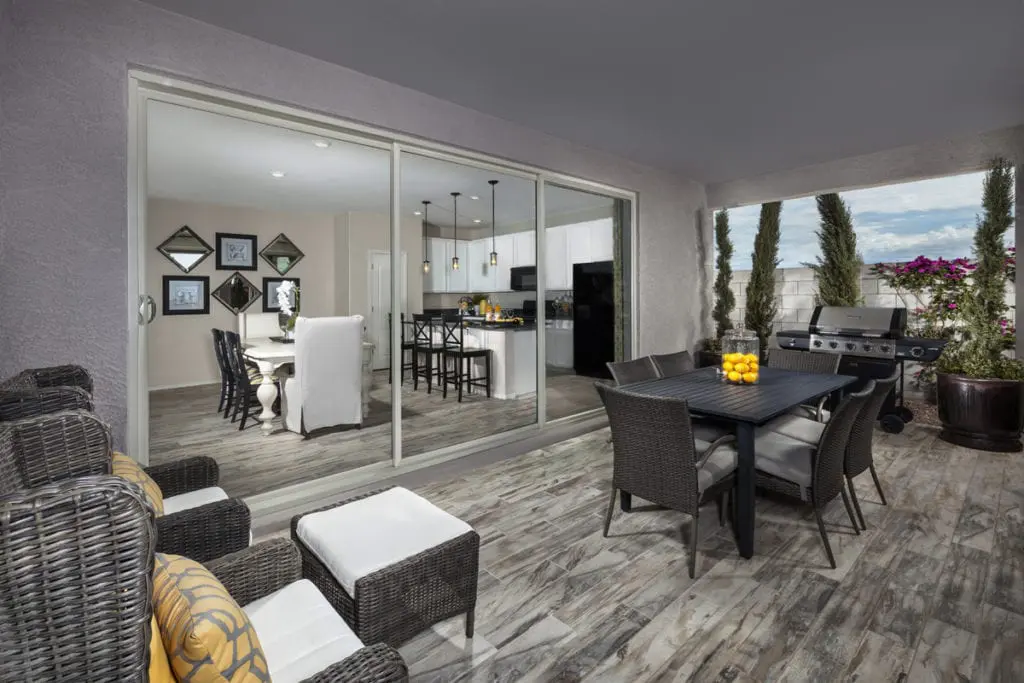
Homebuyer tastes evolve over time. Transport 1950s buyers to an on-trend model home and they might be appalled at the lack of a formal living room or impressed by the abundance of extra bathrooms. But, most of all, they might wonder what happened to the sprawling grassy backyard, which is now just as likely to be a small but functional enclosed patio that extends the family room outside.
“An ongoing trend we see is that buyers care more about function than size indoors and outside,” says Samantha Gilman, senior product development manager for Miller & Smith, a regional homebuilder based in McLean, VA. “Most buyers want a place to cook outside and they want a wide wall of glass that links the outdoor and indoor space to expand their living space.”
Buyer Preferences for Smaller Outdoor Space
Rising land costs are one reason that homebuyers are willing to buy a home with less outdoor space, but there’s also a preference for low maintenance living among many buyers, too, says Mollie Carmichael, a principal of Meyers Research in Costa Mesa, CA.
“In high-cost housing markets, buyers focus on how much they can afford and are willing to compromise on size,” says Carmichael. “In other markets, some people just don’t want to take care of a larger yard.”
Of course, Carmichael points out, the definition of a “small” yard depends on the local housing market. In Minnesota or Salt Lake City, for example, a 15-foot wide backyard might be considered small, while that would be large in Orange County, California or in Washington, D.C., she says.
“The number one reason people want a yard is for privacy from their neighbors, but space to entertain outside is a close second among all buyers,” adds Carmichael.
Seventy-five percent of buyers surveyed for the Meyers Research Consumer Sentiment and Product Insight Survey in spring 2019 said they would be happy to buy a house with a smaller yard – as long as it is designed for entertaining.
“The enthusiasm for smaller yards is across the board in all price ranges, even among luxury buyers,” says Carmichael. “More than half of buyers said they would accept a smaller back yard if it had an outdoor fireplace.”
Designing for Privacy and Function
Creating outdoor living space can be easier with single-family homes, even if they are on small lots, Gilman added.
“You can jog the lot line a little and create some privacy by designing the homes with back-to-back garages,” she says. “In our townhouses, we have recessed outdoor space off the main level with the upper level cantilevered over it. In our higher-end communities, we offer four-story townhouses with a roof terrace and an elevator.”
In high cost housing markets, higher density townhouses are common, says Carmichael.
Carmichael pointed out that in high cost housing markets, higher density townhouses are common.
“An alternative that I think more builders should consider is pulling apart those townhouses a little to get a small yard for privacy,” says Carmichael. “Shifting the townhouses to single-family homes on a small lot often removes the homeowner association fee, which gives the homeowners a little more control over their home and some outdoor space for a barbecue and a place for the puppy and the kids to play.”
For greater privacy in a high-density community, Carmichael recommends a “pocket layout” with the outdoor space designed to be partially enclosed by the house and accessible from the open family room and kitchen. Builders can also create an entertainment bar with an outdoor TV and a small fireplace along an 8-foot-high wall with a trellis to add privacy, she says.
“One thing that’s crucial is to make sure you don’t drown the light coming into the house,” says Carmichael. “A big mistake can be to design a covered patio with a five-foot-high fence just outside the family room. It’s better to design the house with a covered area off the kitchen and an open area off the family room so that the light can come into the family room.”
Miller & Smith typically design their homes with 16-foot sliding glass doors to expand the indoor-outdoor connection and to allow more light into the house, says Gilman. In addition, they keep the indoor ceiling height high to let in more natural light and add skylights to a screened and covered porch to counteract the shade.
“Innovative design starts with thoroughly examining how people live day to day in order to create thoughtful and usable living spaces,” says Ken Gancarczyk, senior vice president of architecture and design for KB Home, based in Los Angeles. “With more and more homebuyers bringing personalization to the backyard, one increasingly popular design trend among KB homeowners is an emphasis on seamless outdoor living.”
More than 80 percent of the buyers surveyed by Meyers Research said they wanted a glass pocket door to connect their indoor and outdoor space, says Carmichael. In addition, the survey found that 85 percent would be willing to pay $5,000 more for a retractable glass wall.
“In those KB communities where the backyard is smaller, our homebuyers are still able to maximize the outdoor living area with seamless transition from indoor to outdoor living,” says Gancarczyk. “Many of our home designs have the great room and kitchen located at the back of the home so entertaining can take place continuously from the inside kitchen to the outdoor patio and living space.”
In many communities, builders compensate for smaller individual yards with more usable common areas for residents who entertain larger groups. “We are finding many homeowners prefer smaller yards because it requires less maintenance and they’re able to use the common areas within the community entertain and enjoy the outdoors,” says Gancarczyk. “Many of our new home communities offer community amenities such as parks, gazebos, open green space and common areas where residents can entertain and host community gatherings to create memories with both family and friends.”
Decorating for Maximum Outdoor Appeal
In a smaller yard, every square foot needs to be functional, says Carmichael.
“You may want a small fireplace, a small waterfall, a covered loggia or even just grass with an attractive tree against the fence for privacy,” she says. “Builders have to show buyers how they could entertain in the space, so even in a seven-square-foot patio on a townhouse it’s smart to build a low wall where guests could sit, put in a barbecue, chairs, a table and an umbrella.”
One option to make both your indoor and outdoor space feel larger is to install the same flooring – or flooring similar in color and material – in the living space adjacent to the outdoor room. For example, KB Home offers indoor/outdoor stone and tile flooring for buyers, says Gancarczyk.
“Most of our buyers choose maintenance-free Trex decks for their outdoor space, which comes in colors that blend with the interior hardwood,” says Gilman.
Black trim on the windows or painted trim all around the windows and doors can draw people’s attention out through the backyard to increase the indoor-outdoor connection, says Gilman.
Shade can also be important for a functional outdoor space.
“Our roof terraces have a cantilevered overhang that extends four to five feet from the house to create shade, and on our townhouses, we offer a screened version or a covered porch option for shade,” Gilman says. “Some vendors offer retractable awnings that offer flexibility for outdoor spaces that we’re looking into because we find that people are willing to spend money on something that makes their home more usable all year.”
Miller & Smith’s model homes showcase some of the ways homeowners can use their outdoor space, such as with a small table and a chaise lounge for a balcony or terrace off a master suite.
“In our model homes, we often have half the porch open and half covered and screened to show buyers how that looks,” says Gilman. “We put seating for dining in the screened section and a grill and string lights for ambiance in the open section.”
Heating elements such as a fire pit, a fireplace or a standalone heater are also popular to demonstrate how the outdoor space can be extended to use in three seasons, she says. Plants can be used to soften the edges of an enclosed yard or to add privacy from an adjacent house, but Gilman says most buyers want those plans to be as low maintenance as possible.
“Our homebuyers have several choices to enhance their outdoor living space, including covered and extended patios, accordion or multi-slide back doors, sunrooms and decks,” says Gancarczyk.
No matter how small a yard is, if it’s designed well, is functional and appealing, homeowners will appreciate it.

Michele Lerner is an award-winning freelance writer, editor and author who has been writing about real estate, personal finance and business topics for more than two decades.
 Getting the Most From Your Model Home Visit
Getting the Most From Your Model Home Visit